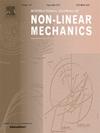ML-based bevel gearbox fault diagnosis: An extensive time domain feature extraction approach with limited data
IF 2.8
3区 工程技术
Q2 MECHANICS
International Journal of Non-Linear Mechanics
Pub Date : 2024-12-26
DOI:10.1016/j.ijnonlinmec.2024.105003
引用次数: 0
Abstract
Data-driven based gear box fault diagnosis is one of the efficient approach as the gear drive train is highly nonlinear parametrically excited system. The data driven approach is solely dependent on the quality of the data acquired from the physical system. These data are direction-sensitive and carry different information depending on the state of the gearbox. In the literature, mostly one-directional data and their traditional time-domain feature matrix are utilized for gearbox fault diagnosis. The proposed work presents for the first time the effect of multi-directional data with a unique technique for data preparation based on various concatenation approaches. Along with this, the fifty extensive time domain features are extracted and fed to three different feature selection (FS) techniques and five popular machine learning (ML)-classifiers for fault diagnosis purposes. An experimental set-up with a bevel gearbox under different fault conditions was used to acquire the vibration signal data using a tri-axial accelerometer. The paper studies the three cases of data preparation: case 1: single-directional data at a time; case 2: horizontal concatenation of multi-directional data at a time; and case 3: vertical concatenation of multi-directional data at a time for gearbox fault diagnosis. Results show that overall, case 3 performed well and gave improved accuracy under different FS techniques and ML-classifiers as compared to cases 1 and 2.
求助全文
约1分钟内获得全文
求助全文
来源期刊
CiteScore
5.50
自引率
9.40%
发文量
192
审稿时长
67 days
期刊介绍:
The International Journal of Non-Linear Mechanics provides a specific medium for dissemination of high-quality research results in the various areas of theoretical, applied, and experimental mechanics of solids, fluids, structures, and systems where the phenomena are inherently non-linear.
The journal brings together original results in non-linear problems in elasticity, plasticity, dynamics, vibrations, wave-propagation, rheology, fluid-structure interaction systems, stability, biomechanics, micro- and nano-structures, materials, metamaterials, and in other diverse areas.
Papers may be analytical, computational or experimental in nature. Treatments of non-linear differential equations wherein solutions and properties of solutions are emphasized but physical aspects are not adequately relevant, will not be considered for possible publication. Both deterministic and stochastic approaches are fostered. Contributions pertaining to both established and emerging fields are encouraged.

 求助内容:
求助内容: 应助结果提醒方式:
应助结果提醒方式:


